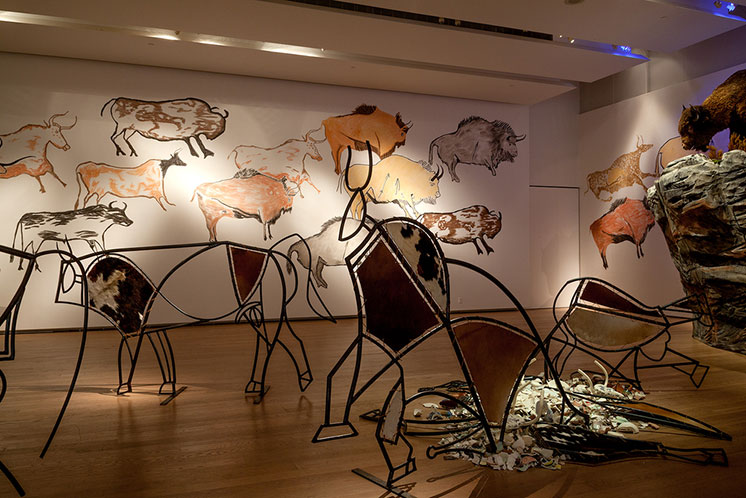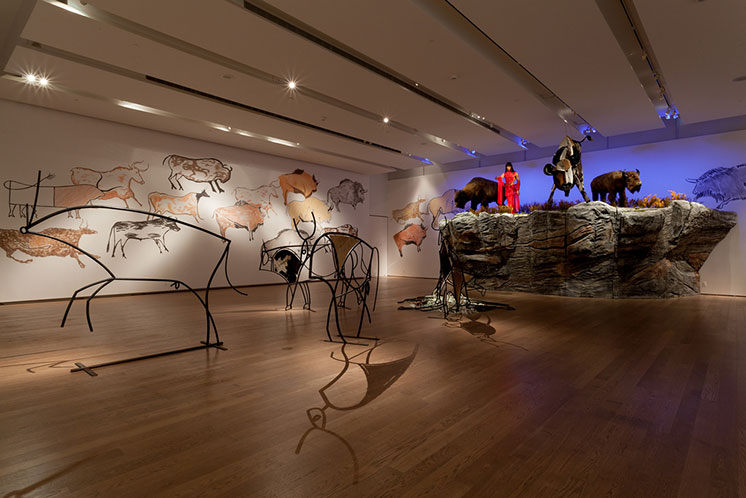
A buffalo jump with Miss Chief Eagle Testickle in The Rise and Fall of Civilization | Image source: kentmonkman.com
Kent Monkman’s art speaks to the resilience of Indigenous people who survived generations of cultural genocide. The Cree artist uses paint, film, performance and installation to instil his messages. Winner of the 2014 Indspire Award for the Arts, today Monkman is a renowned artist who has been featured in numerous solo exhibitions in Canadian museums, participated in various international group exhibitions, and created site specific performances.
Attending The Rise and Fall of Civilization at the Gardiner Museum (October to January 2016) felt like stepping into a whirlwind of Indigenous history. The exhibition journeyed from pre-colonial times to survival under extreme oppression and forced assimilation, to a time of reclamation of culture.
Pictographs of bison were painted on the wall charging towards a sculpture of Monkman’s alter drag queen ego, ‘Miss Chief Eagle Testickle’ as she stood to witness the chaos below. The pictographic style of the bison evoke a time before European contact when Indigenous people and bison flourished. A pile of bison bones and broken shambles of bone china speaks to the chaos that ensued with the arrival of colonization. Indigenous people from the plains maintained a close relationship with the bison, which provided them sustenance at virtually every level including food and shelter. Europeans hunted the bison to near extinction killing them for their pelts, leaving their meat to rot and later collecting their bones to produce bone china. It was this over hunting that played a big part in near decimation of the bison and Indigenous people.
Monkman incorporated aspects of Picasso’s work into the exhibition as a statement on the dual role modern art played in creating a liberal time for Europeans as Indigenous Peoples were being subjugated. As Miss Chief stood surrounded by three bison, one took on a ‘Picasso-esque’ form, as they charged towards a buffalo jump. The Picasso-esque bison rise up from the ruins, signifying the reclamation of culture, values and teachings of Indigenous people today. The Rise and Fall of Civilization embodied the survival journey of the bison on the surface but also symbolizes the survival journey of Indigenous people and culture.
Erica Commanda from MUSKRAT Magazine talked with Kent Monkman about his inspiration behind his work.
MM: You were commissioned for work by the Gardiner in early 2014. Why were you compelled to create The Rise and Fall of Civilization?
KM: My inspiration for museum exhibitions, when I get to explore a collection, comes from the collection itself. I don’t really have an idea of what I will create when I go in to look, so I’m open to discovery. Having not worked with ceramics as a part of my practice, I wasn’t really sure what I was going to do at the Gardiner. I knew that bison bones had been ground up and turned into bone china so that was one of the things I asked to look at. It turns out the Gardiner had a lot of bone china and that was the jumping off point. Also, the size of the gallery was massive, so I had to create something large enough to hold in that size of room. I had the two taxidermy bison for a couple of years already, and I just had to find the right project for them. Everything fit together.
MM: You work with several mediums such as film, performance and installation. Which medium do you feel that you work best with to express yourself?
KM: I started out as a painter, so painting is my primary medium for sure. But I’ve gained a lot through working in other mediums because the other mediums are more collaborative. When you are collaborating with other artists, whether they are performers or cinematographers, your vision expands. When you have other people contributing, refining, and helping you, your vision gets better. I think the collaborative mediums are exciting to me because you can start with a kernel of an idea and watch it grow and blossom into something even better than what you originally imagined. When you are directing, you still get what you want and more. Collaborating with other artists is a very enriching experience. Painting is still the most important to me because it is the most pure form.

MM: Where did you get your inspiration for Miss Chief Eagle Testickle?
KM: There were a few reasons for creating her. When I was looking at the work of 19th century artists, specifically George Catlin, I noted that he was a very self-aggrandizing character and a flamboyant self-promoter. I wanted to create an artistic persona, like Catlin, who could live inside my work, and promote herself, and her own agenda. She was intended to reverse the gaze by turning the European settlers into the subject matter instead of Indigenous people.
I also wanted to create a strong, powerful, two-spirited person that could represent that alternate point of view. I chose to create Miss Chief as a two-spirited person because the tradition of two-spiritedness was present here in indigenous cultures and communities before contact, but was repressed by the colonial governments and the church. I wanted her to also represent the sexualities and gender variance that was present in Indigenous communities across North America that were traditionally accepted and respected.
MM: As you mentioned gender variance was honoured in Indigenous culture. How do people react when you depict that reality in your art?
KM: I think that people are mostly unaware, and many non-Indigenous people are completely unaware. Some Indigenous people are also unaware. There’s homophobia in our communities like anywhere else. We’re not a monolithic voice; we have different opinions in our communities just as much as any other community. Some of us are more conservative than other people. There’s always going to be people that might not understand or respect that point of view but it is important to myself and to my own work.

MM: Your artwork has a lot to say about the impacts of colonization on Indigenous people and the ways Indigenous people are represented in history. What role does your art and Indigenous art in general have in society?
KM: My work, along with other work of Indigenous artists who are putting forward perspectives about First Nations experiences is important in terms of shifting consciousness and awareness about the issues facing First Nations people historically and in the present. I’m just one of many voices. I think my voice adds to a larger collective voice that is trying to bring truth forward about stories and narratives that were suppressed or obliterated through the colonial process.
A lot of my work speaks directly to art history because art history in North America is essentially a document that has told one side of the story – the European settler experience. I’ve gone into art history to examine the dominant narrative, poke holes in it, and challenge the subjectivity of that work: hopefully to reveal truths and ask questions about that one-sided version of history.

Kent Monkman Bio
Kent Monkman is well known for his provocative reinterpretations of romantic North American landscapes. Themes of colonization, sexuality, loss, and resilience – the complexities of historic and contemporary Native American experience – are explored in a variety of mediums, including painting, film/video, performance, and installation. His glamorous diva alter-ego Miss Chief appears in much of his work as an agent provocateur, trickster, and supernatural being, who reverses the colonial gaze, upending received notions of history and Indigenous people. With Miss Chief at centre stage, Monkman has created memorable site specific performances at the McMichael Canadian Art Collection, The Royal Ontario Museum, The Smithsonian’s National Museum of the American Indian, Compton Verney, and most recently at the Denver Art Museum. His award-winning short film and video works have been screened at various national and international festivals, including the 2007 and 2008 Berlinale, and the 2007 and 2014 Toronto International Film Festival. Monkman was awarded the Eagle Leadership Award in 2012, the Indspire Award in 2014 and the Hnatyshyn Foundation Visual Arts Award in 2014. His work has been exhibited internationally and is widely represented in the collections of major Museums in Canada and the USA. He is represented by Pierre-Francois Ouellette Art Contemporain in Montreal and Toronto, Trepanier Baer in Calgary and Peters Projects in Santa Fe.









